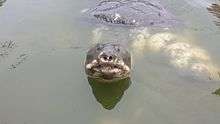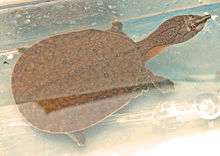Black softshell turtle
| Black softshell turtle | |
|---|---|
 | |
| Scientific classification | |
| Kingdom: | Animalia |
| Phylum: | Chordata |
| Class: | Reptilia |
| Order: | Testudines |
| Suborder: | Cryptodira |
| Family: | Trionychidae |
| Genus: | Nilssonia |
| Species: | N. nigricans |
| Binomial name | |
| Nilssonia nigricans | |
| Synonyms[3][4] | |
The black softshell turtle or Bostami turtle (Nilssonia nigricans, previously placed in genus Aspideretes) is a species of freshwater turtle found in India (Assam) and Bangladesh (Chittagong and Sylhet). It was long believed to be inbred individuals of the Ganges softshell turtle (A. gangeticus or N. gangeticus) or the Indian peacock softshell turtle (A. hurum or N. hurum), but while it is a close relative of the latter, it is a distinct species.[5]
Habitat
Originally native to the lower Brahmaputra River, the only population ever reliably known consists of a small number of the species in a man-made pond which is part of the Bayazid Bastami shrine at Chittagong, where they are dependent on humans for survival. To the locals and worshipers, the black softshell turtle is known as mazari ("Mazar inhabitant"); specimens from this shrine were used in the first scientific description.[5][6]
In a 2014 survey by Poribesh Banchao Andolon, a Bangladeshi private organization it was found that the amount of oxygen dissolved in the pond water was 2.01 mg/L, whereas the favorable level is 5 mg/L.[7] In 2012, wildlife biologists of the Center for Advanced Research in Natural Resources and Management found a small population in the wild of Sylhet.[7] Two tiny wild populations were discovered in Assam, in Kaziranga and in the Jia Bhoroli River which is a northern tributary of the Brahmaputra. Also, another temple population of these turtles was identified in the Kasopukhuri pond on Nilachal Hill, next to the Kamakhya Temple at Guwahati in Assam.[8]
Near-extinction in the wilderness
As of 2002, the IUCN classified the species as Extinct in the Wild.[2] In 2004, 408 turtles were found in the pond of the Bayazid Bastami shrine. According to the shrine committee staff, 90 more turtles were hatched in the pond in 2007, 74 in 2008, 96 in 2009, 28 in 2010, 45 in 2012 and 40 in 2014.[7]
In 2017, a singular wild turtle was found in the wetlands of Old Akuk Village in Wokha District, Nagaland. DNA from the specimen sent to Bangladesh was tested and ultimately confirmed that it was a member of the black softshell species.[9]
Conservation efforts
Since 2013, TSA India has worked diligently to improve conditions at selected temple ponds in Assam where these turtles were discovered. Many of the ponds were eutrophic and overcrowded and often, turtles were fed human food as religious offerings. The turtles showed signs of poor nutrition and a lack of suitable nesting space resulted in eggs being deposited in areas where there was little chance of hatching. The goal of the project is to eventually rear and release juveniles from these captive colonies to supplement depleted wild populations. As part of that initiative, the TSA India team camped at the Nagshankar temple in April to observe nesting in the 40-45 adult females at that location. At that time, the team transferred ten nests to a hatchery and protected four nests onsite.
With TSA's efforts 44 turtles have hatched so far. The team is currently expanding headstarting facility at Nagshankar temple to accommodate this year's hatchlings. Neonates and juveniles cannot be released back into the temple pond due to predation by larger turtles and exotic fish. For this reason, the team acquired an earthen pond in the nearest village to provide space for the fast-growing juveniles, improving survival prospects for this extremely rare softshell.
References
- 1 2 Rhodin 2011, p. 000.207
- 1 2 3 IUCN Status report
- ↑ Fritz Uwe; Peter Havaš (2007). "Checklist of Chelonians of the World" (PDF). Vertebrate Zoology. 57 (2): 311. ISSN 1864-5755. Archived from the original (PDF) on 2010-12-17. Retrieved 29 May 2012.
- ↑ "Nilssonia nigricans ". The Reptile Database. www.reptile-database.org.
- 1 2 Praschag et al. (2007)
- ↑ Anderson (1875), Praschag et al. (2007)
- 1 2 3 Uddin, Minhaj. "Rare Bostami Turtles of Ctg city in peril". The Daily Star. Retrieved 2015-08-17.
- ↑ Asmat (2002), Praschag & Gemel (2002), Praschag et al (help is on the way). (2007)
- ↑ Longchar, Imiti. "Turtle species thought extinct in the wild discovered in Nagaland". Morung Express. Retrieved 2017-03-24.
Bibliography
- Rhodin, Anders G.J.; van Dijk, Peter Paul; Iverson, John B.; Shaffer, H. Bradley; Roger, Bour (2011-12-31). "Turtles of the world, 2011 update: Annotated checklist of taxonomy, synonymy, distribution and conservation status" (PDF). Chelonian Research Monographs. 5. Archived from the original (PDF) on 2012-01-22.
Further reading
- Anderson J (1875). "Description of some new Asiatic Mammals and Chelonia". Ann. Mag. Nat. Hist., Fourth Series 16: 282–285. (Trionyx nigricans, new species, pp. 284–285).
- Praschag P, Gemel R (2002). "Identity of the black softshell turtle Aspideretes nigricans (Anderson 1875) with remarks on related species". Faunistische Abhandlungen 23: 87–116.
- Praschag P, Hundsdörfer AK, Reza AHMA. Fritz, U (2007). "Genetic evidence for wild-living Aspideretes nigricans and a molecular phylogeny of South Asian softshell turtles (Reptilia: Trionychidae: Aspideretes, Nilssonia)". Zool. Scripta 36 (4): 301–310. (Nilssonia nigricans, new combination). doi:10.1111/j.1463-6409.2007.00282.x (HTML abstract).
External links
| Wikispecies has information related to Nilssonia nigricans |

